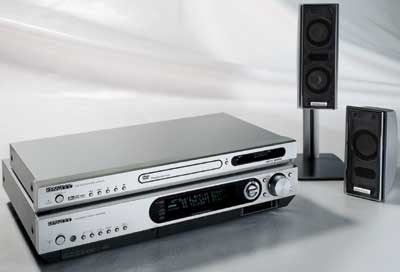Convergence Page 3
| Bringing the Network Home | |
| While you couldn't help but notice that flat-panel displays were everywhere at CES, there was another important but much less visible trend in the works: audio and video components are becoming increasingly connected to each other and to home networks. For example, the media receiver - a device that moves files from a PC to an A/V system - was well represented. Perhaps the most interesting was Prismiq's diskless MediaPlayer/ Recorder (click to read more). Not surprisingly, networking is part of the broad movement toward wireless connections. Wi-Fi Ethernet was seen in everything from the newest version of OmniFi's Digital Media Streamer (the original won an S&V Reviewer's Choice Award last year) - which can now stream video as well as audio to your car - to networking cards for desktop and laptop computers and access points for home networks from companies like Belkin, D-Link, and Motorola. While products built for the IEEE 802.11g Wi-Fi specification are flying off shelves, new technologies like 802.11n and 802.11e were generating some buzz. The "n" standard roughly doubles the data rate of "g" from 54 megabits per second (Mbps) to 100 Mbps. In theory, "g" should be fast enough even for multiple streams of video over a network. But in the real world, smooth video streaming has been a problem because of distance, overloaded networks, and interference from other Wi-Fi networks, microwave ovens, cordless phones, and other devices that also operate in the 2.4-GHz band. The other emerging wireless standard, 802.11e, identifies and gives priority to multimedia content, like streaming video and audio files, so it can guarantee a minimum quality of service. Look for products using these new wireless technologies late this year. A/V manufacturers are clearly embracing the networked world, modifying traditional components to take on media-server capabilities. For example, the hard-disk-equipped Denon Network Server (available mid-year for about $4,500) acts as a hard-disk video recorder plus a music server and includes two TV tuners, two FM tuners, and a CD drive. Tabletop "clients" can be connected to bring networked content to local TVs and audio systems. Kenwood's NHT-S810DV system (expected to sell for about $1,100) includes a DVD player, an A/V receiver, and a 6.1-channel speaker system. But its most interesting feature is an Ethernet port for streaming audio and video from a computer on the home network. While wired network devices can be a problem in existing houses and apartments, where they have to be retrofitted, wireless technology isn't always the answer. That's why eight diverse companies - Cisco, Comcast, EchoStar, Entropic, Motorola, Panasonic, RadioShack, and Toshiba - joined to form MoCA, the Multimedia over Cable Alliance. The Alliance is looking to develop specifications and certify A/V accessories that can tap into the vast amounts of unused bandwidth available via the coaxial cable already installed in most homes without requiring any new wiring. The HomePlug Powerline Alliance, meanwhile, showed how high-definition video and audio can be distributed over standard power lines - even ordinary extension cords - using a new technology called HomePlug AV. Although speeds are currently limited to a maximum of about 170 Mbps - enough, theoretically, to stream three high-def and two standard-def video signals around a home - the Alliance is hoping to reach gigabit speeds within a few years. Look for the first HomePlug AV devices by year's end - probably peripherals, but we could see some TVs as well. - Brian C. Fenton | |
 | |
| Kenwood's NHT-S810DV 6.1 channel home theater system features an Ethernet port for streaming audio and video over a home network. | |
| < < Convergence | CES 2004 Showstoppers >> |




























































